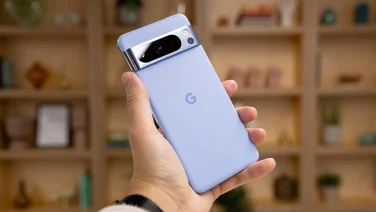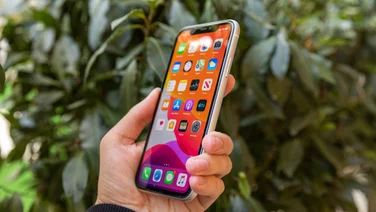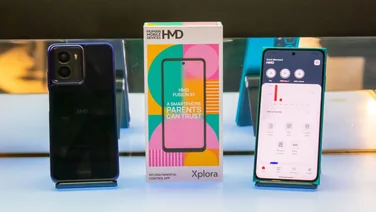To help us provide you with free impartial advice, we may earn a commission if you buy through links on our site. Learn more

It didn’t take much for EE’s £200 Harrier to stand out from the crowd, as decent mid-range handsets are still hard to come by. Things aren’t so simple for the smaller Harrier Mini though. At £100 on EE’s Pay-As-You-Go service, it’s in direct competition with Motorola’s budget champion, the 2nd Gen Moto E.
On paper, the Harrier Mini puts up an extremely good fight. Its 4.7in display has a higher 1,280×720 resolution, the rear camera has a larger 8-megapixel sensor, and its 124g, 9.5mm thick chassis is both lighter and slimmer than the Moto E by quite a margin. Motorola’s colourful bands and grip shells might let you customise the Moto E, but the Harrier Mini’s brushed metal effect finish and yellow camera module give it a little more personality than the usual black slabs we see at this end of the market.
Display
While we appreciate the extra screen resolution, image quality was decidedly less impressive. Our colour calibrator measured a disappointing 84.9% sRGB colour gamut coverage, which is pretty poor even by budget phone standards. Red and green coverage were the main areas of weakness, making the screen appear quite cool overall. This meant images weren’t quite as vivid as we would like, but at least black levels of 0.26cd/m2 meant that blacks were always deep and inky.

A contrast ratio of 1,395:1 was great too, ensuring plenty of detail was present, although viewing angles did tend to drop off slightly if we weren’t looking at the phone head on. Likewise, with a peak white level of 366.95cd/m2, you’ll have to set the screen to max brightness if you want to use the phone outside – any less and you’ll struggle to see the screen clearly.
Camera
The 8-megapixel rear camera also failed to leave much of a mark. There was a decent amount of detail present in the centre of the frame, but the right hand side struggled to focus correctly, which meant that some objects lost definition around the edge of our test shots. Likewise, shadow areas were extremely dark, which made the whole picture look very dingy. Switching to HDR mode did help in these situations, but colours still veered toward the dark side despite the increase in exposure.


Indoor performance was pretty decent, though, as colours looked much richer in our still life shots and we only started to see a noticeable amount of noise when we switched off our external lamp. We also didn’t see any obvious blurring on the right hand side of the frame either.


Performance
The Harrier Mini’s day-to-day performance, however, was great for such a cheap handset. Despite sharing the same quad-core, 1.2GHz Qualcomm Snapdragon 410 processor and 1GB of RAM as the Moto E, the Harrier Mini was actually faster in nearly all of our benchmark tests. For instance, its score of 505 and 1,471 in Geekbench 3’s single and multicore tests was a fraction higher than the Moto E’s scores of 470 and 1,397. We could see the difference in day-to-day use, too, as apps and menu settings loaded a fraction quicker on the Harrier Mini than the Moto E.
We’re also pleased to see that EE’s stuck with a vanilla version of Android 5.0.2 and has kept pre-installed app clutter to a minimum. There are a few fullscreen widgets you’ll probably want to get rid of, but everything you need as an EE customer can be found in the My EE app. This lets you check how much data, minutes and texts you have left each month, as well as top-up, buy add-ons and access the EE Store. Likewise, EE’s recently launched Wi-Fi calling service, which lets you make and receive calls over Wi-Fi if your signal drops out, will be available to use directly from the dialler later this summer.

Its score of 699 in FutureMark’s Peacekeeper browser test was also a touch higher than the Moto E’s figure of 625, but the difference here was less noticeable when we compared the two phones side by side. Web browsing was relatively smooth, but we did see the odd sign of lag when we tried scrolling down the Guardian’s homepage while it was still loading, for instance.
We were less impressed with the Harrier Mini’s graphics performance, though, as it failed to finish the offscreen Manhatten test in our GFX Bench GL benchmark. This isn’t surprising, as the Moto E only finished with a score of 112 frames (or 1.8fps), but it does mean that it will struggle with more demanding games such as Blizzard’s Hearthstone. When we tried the game out for ourselves, card battles were just about playable, but a few animations and various speech bubbles showed some considerable slowdown in the overall frame rate.
Battery Life
The Harrier Mini’s battery life was more promising, as its 2,000mAh battery lasted 10h 53m in our continuous video playback test with the screen brightness set to 170cd/m2. This should be more than enough to last you through the day, but it still pales in comparison to the Moto E’s battery life of 13h 30m.

Conclusion
As a result, the Harrier Mini isn’t nearly as good a bargain as its Harrier big brother. EE also shoots itself in the foot with its high contract prices. For instance, the Moto E is available on Carphone Warehouse’s iD Network for just £8.50-a-month with an upfront cost of £20 for 500MB of data, while the equivalent contract on EE costs a massive £14.99-a-month with no upfront cost. That’s the same price as the Sony Xperia M4 Aqua, which has a much faster processor and a superior camera, making the Sony handset much better value on contract. Alternatively, there’s also the superb Vodafone Smart Ultra 6 to consider if you’re thinking of changing networks, as this is only £125 on PAYG or £17-per-month on contract and blows every other budget handset out of the water, including the Moto E.




